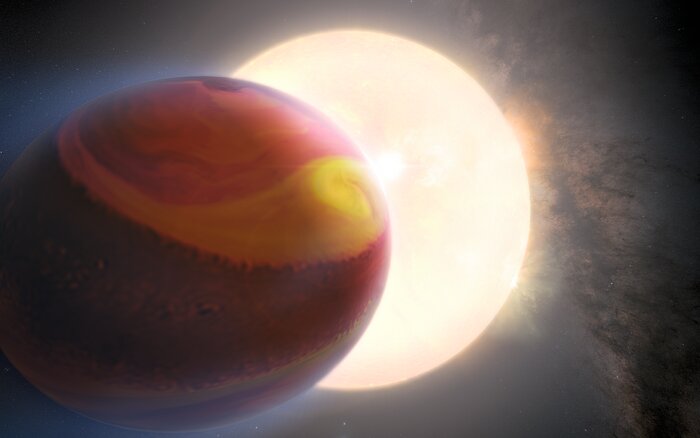When it comes to understanding exoplanets, or planets outside our solar system, the big challenge is in not only finding these planets, but also understanding what they are like. And one of the biggest factors that scientists are interested in is whether an exoplanet has an atmosphere and, if so, what it is composed of. But, just like with weather here on Earth, exoplanet atmospheres aren’t static. So the Hubble Space Telescope was recently used for an intriguing observation — comparing data from an exoplanet atmosphere that had previously been observed, to see how it changed over time.
Hubble looked at planet WASP-121 b, an extreme planet that is so close to its star that a year there lasts just 30 hours. Its surface temperatures are over 3,000 Kelvins, or 5,000 degrees Fahrenheit, which researchers predict would lead to some wild weather phenomena. As it is such an extreme planet, WASP-121 b is well-known and has been observed by Hubble several times over the years, beginning in 2016.

In total, the researchers combined four sets of observations that were made using Hubble, processing each to get a picture of how the planet changed over the years. “Our dataset represents a significant amount of observing time for a single planet and is currently the only consistent set of such repeated observations,” said researcher Quentin Changeat of the Space Telescope Science Institute in a statement.
“The information that we extracted from those observations was used to characterize (infer the chemistry, temperature, and clouds) of the atmosphere of WASP-121 b at different times. This provided us with an exquisite picture of the planet, changing in time,” he said.
The researchers produced a stunning video showing the weather patterns they modeled on the planet. The footage was slowed down to show the patterns more clearly, and the results are thought to be due to huge cyclones in the planet’s atmosphere. These are created because one side of the planet always faces its star, so it gets much hotter than the side facing into space, and the huge temperature difference creates this dramatic weather.
Understanding more about the weather on this exoplanet can help scientists learn about weather on other planets, which will become more important as more observations are made of exoplanet atmospheres.
“Weather on Earth is responsible for many aspects of our life, and in fact, the long-term stability of Earth’s climate and its weather is likely the reason why life could emerge in the first place,” said Changeat. “Studying exoplanets’ weather is vital to understanding the complexity of exoplanet atmospheres, especially in our search for exoplanets with habitable conditions.”
The research will be published in the Astrophysical Journal Supplement Series.



